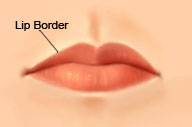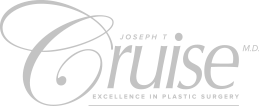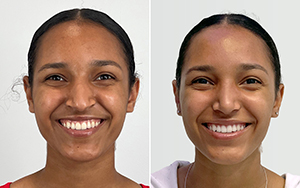Lip Augmentation-Faq’s
Lip Augmentation Frequently Asked Questions (FAQs)
- Lip Augmentation Overview
- Lower Face Rejuvenation
- Are You a Good Candidate?
- Benefits of Lip Augmentation
- Joseph T Cruise, MD’s Lip Augmentation Philosophy
- Lip Augmentation FAQ’s
- Prior to Lip Augmentation
- Lip Augmentation Anesthesia
- After the Lip Augmentation
- Recovery from Lip Augmentation
- Possible Complications
- Lip Augmentation Cost and Financing
- Lip Augmentation Words to Know
- Lip Augmentation Before and After Pictures
|
How does Hyaluronic Acid work? Restylane® and Juvéderm® are hyaluronic acids. Hyaluronic acid is part of the structure of normal, healthy skin.The role of hyaluronic acid is to deliver nutrients, hydrate the skin by holding water, and to act as a cushioning agent. It diminishes with age. Adding Restylane® or Juvéderm® adds structural volume similar to what is naturally found in the lips and skin. |
 Chains of Hyaluronic Acid attract water, this increases soft tissue volume. |
|
What is the difference between Restylane® and Juvéderm®? Both Restylane® and Juvéderm® are non-animal stabilized hyaluronic acids. Joseph T Cruise, MD uses both extensively and, quite frankly, does not see a significant difference. The company that makes Restylane® claims its product lasts a little bit longer. The company that makes Juvéderm® claims Juvéderm® has less swelling and bruising and is softer. |
How long does lip augmentation last?
Here is another question that is hard to get a straight answer. The reason is that if you listen to the makers of Restylane® or Juvéderm® you will certainly get an inflated amount of time. In reality, to maintain your lips you should expect to repeat the augmentation every 4-6 months.
Quotes from patients:
"I had my lips injected with 2 syranges of Juvéderm® about 10 months ago and I still see the results."
"I had soft tissue fillers in the past and they lasted only a few months."
To read more reviews of Lip Enhancement go to RealSelf.com
Can I have just one lip done?
Yes. If, for example, your lower lip is already pouty you can have just the upper done. One caveat, it is important to make sure you get enough of the product. By only doing a little amount most patients do not get the ideal result they are looking for.
How much is enough?
When discussing volumes you must talk in terms of cubic centimeters or cc's. This is how all soft tissue fillers are packaged. Captique® comes in 3/4 cc tubes. Restylane® comes in 0.4 cc and 1 cc tubes.
1/2 cc per lip. This will produce a small result and but usually is not enough. It is good for touch ups. Remember, you must double the amount if you have both lips done.
3/4 cc per lip. This will provide a very nice result and is usually enough for patients who do not want to be too dramatic. 3/4 cc per lip is probably the best amount to start out with until you determine what volume is best for you.
1cc per lip. This will normally produce a more dramatic look. Conservative patients should not start out with 1cc per lip - it may be too much.
1.5 cc per lip. This will provide a dramatic enlargement of the entire lip. With this amount both the central lip and corners of the mouth can be enlarged.
Should I augment the corners of the mouth or just the center of the lips?
It depends. This stuff is expensive. Therefore, if money is a concern your best result would be to do mainly the central portion. The central portion provides the most dramatic effect. Augmenting the corners, however, provides a great look as well. If you do 1cc per lip then you usually have enough to do the corners as well. Some people who want a dramatic look for both the central lip and the corner of the mouth ask for 1 to 1.5cc per lip.
Should I augment the lip border (vermillion border)?
|
Most people do not. If you have it done, make sure it is by an experienced physician. If it is placed too high above the lip border it does not look good. Joseph T Cruise, MD likes Cosmoderm® to highlight the lip border. Cosmoderm® can be placed very accurately and defines the lip roll very nicely. Cosmoderm®, however, does not last as long as Restylane® or Captique®. It lasts about 2-3 months. Do I need local anesthesia to have my lips enlarged? |
 Lip border can be augmented in addition to the lip. |
No. Joseph T Cruise, MD, however, prefers to numb his patients but many physicians do not.
When can I go out in public after lip augmentation?
Often, people will go back to work the next day without a problem. However, it takes a day or two for the swelling to go down. So, if you are very concerned and do not want to be obvious, give yourself about 2-3 days out of the public eye.
What about fat to enlarge the lips?
The major advantage of fat is that it is permanent. The problem is that it does not survive predictably within the lips because the lips move so much. This can leave lumpiness. Another disadvantage is that it creates serious swelling that takes about 3 weeks to go away. For these reasons it is not used often for lip augmentation.
What about the other fillers such as Radiesse® and Sculptra®?
Both Radiesse® and Sculptra® are relatively new fillers that show promise of having greater longevity than hyaluronic acid. Currently Radiesse® is not approved by the FDA for facial soft tissue filling but is being used world wide for this purpose. Sculptra® has just recently been approved by FDA.
Radiesse® is made of very tiny, smooth calcium hydroxylapatite micro spheres. When injected into the body the micro spheres form a scaffold into which collagen grows. The results may last greater than a year. The feel, however, can be firmer than what a lip normally feels.
Sculptra® ia a poly-L-lactic acid. It is a compound that has been used in surgery for many years and has been shown to be safe. It requires a series of injections usually 6 weeks apart. It actually degrades but the dermis has been shown to thicken after it is degraded. Time will tell how effective it is as a soft tissue filler but is not a good option for lip augmentation.





